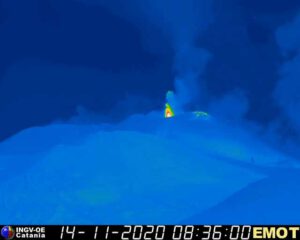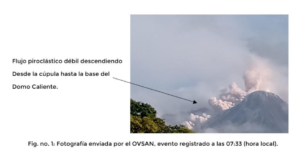 Another report from INSIVUMEH about the eruptions at Santiaguito volcano in Guatemala is available: Weak and moderate explosions were recorded. These can generate columns with large amounts of gas and with heights up to 3300 meters (10,826 feet). There are also avalanches of blocks and ash towards the southwest flank mainly, however, these can be generated towards the south, southeast and west flanks. The path of such material reaches the base of the dome and causes fine ash particles to fall on the volcanic perimeter. Due to the location of block lava flows in the dome of the hot dome in a west-southwest direction, the occurrence of block and ash flows in this same direction, as well as long range pyroclastic flows, is not ruled out. For short periods of time it is possible to hear aircraft turbine like sounds due to the prolonged degassing in the hot dome.
Another report from INSIVUMEH about the eruptions at Santiaguito volcano in Guatemala is available: Weak and moderate explosions were recorded. These can generate columns with large amounts of gas and with heights up to 3300 meters (10,826 feet). There are also avalanches of blocks and ash towards the southwest flank mainly, however, these can be generated towards the south, southeast and west flanks. The path of such material reaches the base of the dome and causes fine ash particles to fall on the volcanic perimeter. Due to the location of block lava flows in the dome of the hot dome in a west-southwest direction, the occurrence of block and ash flows in this same direction, as well as long range pyroclastic flows, is not ruled out. For short periods of time it is possible to hear aircraft turbine like sounds due to the prolonged degassing in the hot dome.
 Marc Szeglat
Marc Szeglat
Pacaya: Lava flow still active
 INSIVUMEH reports today that the Pacaya is still active. Due to night and early morning weather conditions, visibility to the Mackenney cone and its crater was limited. The PCG and PCG5 seismic stations register tremors associated with the rise of magma and constant degassing. Lava flow in southwest direction one of 1,025 meters in length, approximately. The lava flow is clearly visible on sentinel satellite images.
INSIVUMEH reports today that the Pacaya is still active. Due to night and early morning weather conditions, visibility to the Mackenney cone and its crater was limited. The PCG and PCG5 seismic stations register tremors associated with the rise of magma and constant degassing. Lava flow in southwest direction one of 1,025 meters in length, approximately. The lava flow is clearly visible on sentinel satellite images.
Klyuchevskoy: Vulcanian eruptions
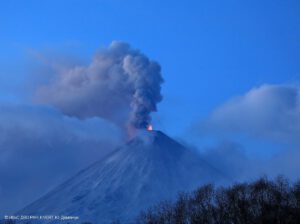 The Klyuchevskoy is located on the Russian peninsula of Kamchatka and continues to erupt effusively and explosively. It produces vulcanian eruptions that produce glowing tephra and volcanic ash. The latter reaches heights of up to 7600 m above sea level. Thus, the eruption clouds rise a good 2800 m above the summit of the volcano. Normally, the volcanic eruptions are generated in the course of paroxysmal activity. In this case, the frequent strombolian eruptions increase within a short period of time, only to subside quite quickly after a plateau phase. The effusive activity also continues. MIROVA recorded a thermal anomaly tonight with a power of 1265 MW. The lava flow has a length of about 2 km. At its front it seems to have widened a bit during the last days. The photo shows a phase of increased activity and was taken by the director of the observatory in Klyuchi on 18. November.
The Klyuchevskoy is located on the Russian peninsula of Kamchatka and continues to erupt effusively and explosively. It produces vulcanian eruptions that produce glowing tephra and volcanic ash. The latter reaches heights of up to 7600 m above sea level. Thus, the eruption clouds rise a good 2800 m above the summit of the volcano. Normally, the volcanic eruptions are generated in the course of paroxysmal activity. In this case, the frequent strombolian eruptions increase within a short period of time, only to subside quite quickly after a plateau phase. The effusive activity also continues. MIROVA recorded a thermal anomaly tonight with a power of 1265 MW. The lava flow has a length of about 2 km. At its front it seems to have widened a bit during the last days. The photo shows a phase of increased activity and was taken by the director of the observatory in Klyuchi on 18. November.
Santiaguito: Eruption with pyroclastic flows
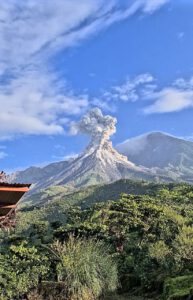 The Santiaguito in Guatemala erupted explosively yesterday, generating small pyroclastic flows. Volcanic ash rose to an altitude of 4600 m and drifted in a southwestern direction. Ash fall was reported from some communities around the volcano.
The Santiaguito in Guatemala erupted explosively yesterday, generating small pyroclastic flows. Volcanic ash rose to an altitude of 4600 m and drifted in a southwestern direction. Ash fall was reported from some communities around the volcano.
The Santiaguito are several generations of lava domes that formed in the collapsed flank of the larger Santa Maria Volcano. Currently only one dome is growing and this at low speed. Every day there are smaller explosions and the descent of rockfalls and debris avalanches. Pyroclastic flows are often generated in phases of increased activity.
Stromboli: Explosion and pyroclastic flow
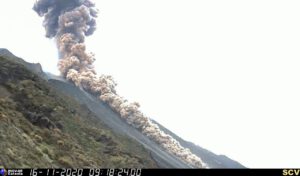 At the Italian volcano Stromboli a stronger explosion occurred this morning at 10.18 am (local time). It apparently triggered a collapse in the crater area and a pyroclastic flow, was created. Volcanic ash rose several hundred meters above crater height. It is the 2nd stronger-than-usual eruption within 6 days. The other activity parameters are remarkably inconspicuous or very low. This morning the LGS reported very weak eruptions with an acoustic pressure of only 0.05 bar.
At the Italian volcano Stromboli a stronger explosion occurred this morning at 10.18 am (local time). It apparently triggered a collapse in the crater area and a pyroclastic flow, was created. Volcanic ash rose several hundred meters above crater height. It is the 2nd stronger-than-usual eruption within 6 days. The other activity parameters are remarkably inconspicuous or very low. This morning the LGS reported very weak eruptions with an acoustic pressure of only 0.05 bar.
Pacaya: Significant increase in eruptive activity
 At the Guatemalan volcano Pacaya, volcanic activity increased significantly yesterday afternoon. Social media reports published images showing an ash cloud rising from the flank of the McKenney crater cone. Some comments say that a new crater has formed. However, other phenomena may also cause ash to rise from the flank: One would be the formation of a fracture (fissure) from which a new lava flow flows. On the other hand, blocks could break off from the front of a lava flow and trigger ash flows. CONRED warns of an increase in activity and reports that blocks up to 3 m in size break off from the center of the cone. The block avalanches are moving on the southwest flank of the volcano.
At the Guatemalan volcano Pacaya, volcanic activity increased significantly yesterday afternoon. Social media reports published images showing an ash cloud rising from the flank of the McKenney crater cone. Some comments say that a new crater has formed. However, other phenomena may also cause ash to rise from the flank: One would be the formation of a fracture (fissure) from which a new lava flow flows. On the other hand, blocks could break off from the front of a lava flow and trigger ash flows. CONRED warns of an increase in activity and reports that blocks up to 3 m in size break off from the center of the cone. The block avalanches are moving on the southwest flank of the volcano.
Etna: Thermal anomalys detected
At Etna in Sicily strombolian eruptions can be observed today. They originate from the New South East Crater and create a distinct thermal anomaly: MIROVA registers a high thermal radiation with a power of 116 MW. It comes from the tephra deposited in the crater. In the conveyor system, the magma stands high. On a 3 day old satellite image 2 small hotspots in Bocca Nuova were also visible. Another anomaly was found in the Northeast Crater.
More informations about Mount Etna on the mainpage.
Stromboli: larger eruption on 10.11.20
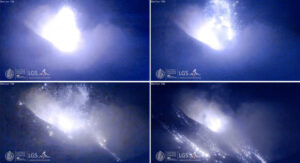 Yesterday evening at 20:04 a major explosive eruption occurred on Stromboli. Glowing tephra covered the crater and its southern flank. However, it is not yet clear whether larger cinders also landed on the Cima and Pizzo. According to first reports the measuring instruments remained undamaged. The explosion was preceded by a 4 minute inflation phase. It raised the inclinometer on the Rina Grande by 1 µrad. The threshold value for the duration of the soil uplift was not reached and so the automatic paroxysm early warning system did not trigger an alarm. Nor was the eruption a paroxysm, but a single explosion. Such explosions occur again and again on Stromboli, even during relatively calm phases, as we are currently experiencing on Stromboli. All parameters of the daily events at the volcano were inconspicuous in the run-up to the explosion. The activity index has been set to “low” for quite some time.
Yesterday evening at 20:04 a major explosive eruption occurred on Stromboli. Glowing tephra covered the crater and its southern flank. However, it is not yet clear whether larger cinders also landed on the Cima and Pizzo. According to first reports the measuring instruments remained undamaged. The explosion was preceded by a 4 minute inflation phase. It raised the inclinometer on the Rina Grande by 1 µrad. The threshold value for the duration of the soil uplift was not reached and so the automatic paroxysm early warning system did not trigger an alarm. Nor was the eruption a paroxysm, but a single explosion. Such explosions occur again and again on Stromboli, even during relatively calm phases, as we are currently experiencing on Stromboli. All parameters of the daily events at the volcano were inconspicuous in the run-up to the explosion. The activity index has been set to “low” for quite some time.
Karymsky: Eruption update 09.11.20
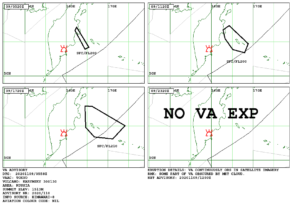 Since yesterday, the Karymsky erupts again ash clouds on Kamchatka (Russia). The VAAC issued 4 VONA warnings for air traffic. Volcanic ash was detected at 6000 m altitude. The ash drifted in northeast direction. Further eruptions of the remote volcano are expected.
Since yesterday, the Karymsky erupts again ash clouds on Kamchatka (Russia). The VAAC issued 4 VONA warnings for air traffic. Volcanic ash was detected at 6000 m altitude. The ash drifted in northeast direction. Further eruptions of the remote volcano are expected.
In the literature Karymsky is often mentioned as the most active volcano of Kamchatka. Until 2016, the volcano was permanently active and erupted several times a day. But this has changed significantly in the meantime. In the meantime, the Karymsky is active in phases and breaks of several months can occur. The Klyuchevskoy, which erupts more frequently and more strongly in the meantime, competes with the Karymsky.
Klyuchevskoy: Activity increases
 The volcano on Kamchatka put on an impressive performance yesterday. The output of lava increased. MIROVA registered the highest value of thermal radiation to date: 1454 MW. So the lava flow might have become longer than 1 km. At the moment a power of 1000 MW is still registered. On the LiveCam one could observe large strombolian eruptions. This morning an ash cloud was erupted. According to the VAAC it rose up to a height of 6000 m.
The volcano on Kamchatka put on an impressive performance yesterday. The output of lava increased. MIROVA registered the highest value of thermal radiation to date: 1454 MW. So the lava flow might have become longer than 1 km. At the moment a power of 1000 MW is still registered. On the LiveCam one could observe large strombolian eruptions. This morning an ash cloud was erupted. According to the VAAC it rose up to a height of 6000 m.
